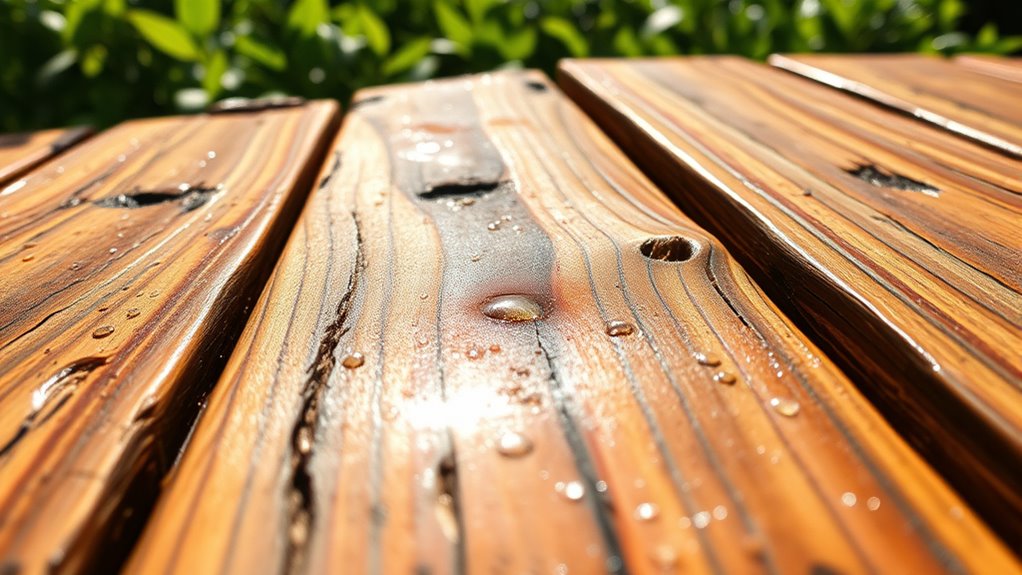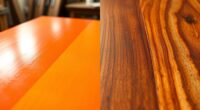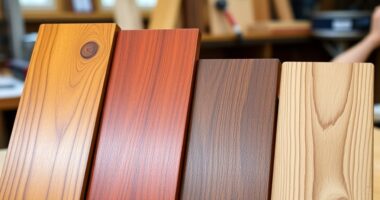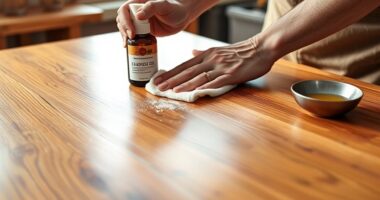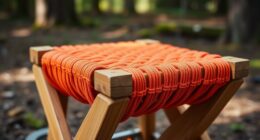To safeguard wood from moisture and UV damage, apply natural oils like linseed or tung to create a waterproof barrier. Use synthetic sealants with proper surface prep and multiple thin coats, especially for outdoor surfaces. Incorporate UV-resistant finishes like spar varnish and install physical barriers such as shades or overhangs. Regular maintenance and choosing the right coatings can ensure long-lasting protection, and you’ll discover more effective strategies as you explore further.
Key Takeaways
- Apply penetrating oils like linseed or tung oil to create durable, waterproof barriers that protect against moisture intrusion.
- Use UV-stabilized finishes such as spar varnish or tinted coatings to block harmful ultraviolet rays.
- Incorporate physical barriers like shading, overhangs, or UV screens to minimize direct sun exposure.
- Regularly inspect and reapply protective coatings to maintain moisture and UV resistance over time.
- Store wood in dry, covered areas and use vapor barriers during installation to prevent moisture penetration.
Natural Oils for Moisture Resistance
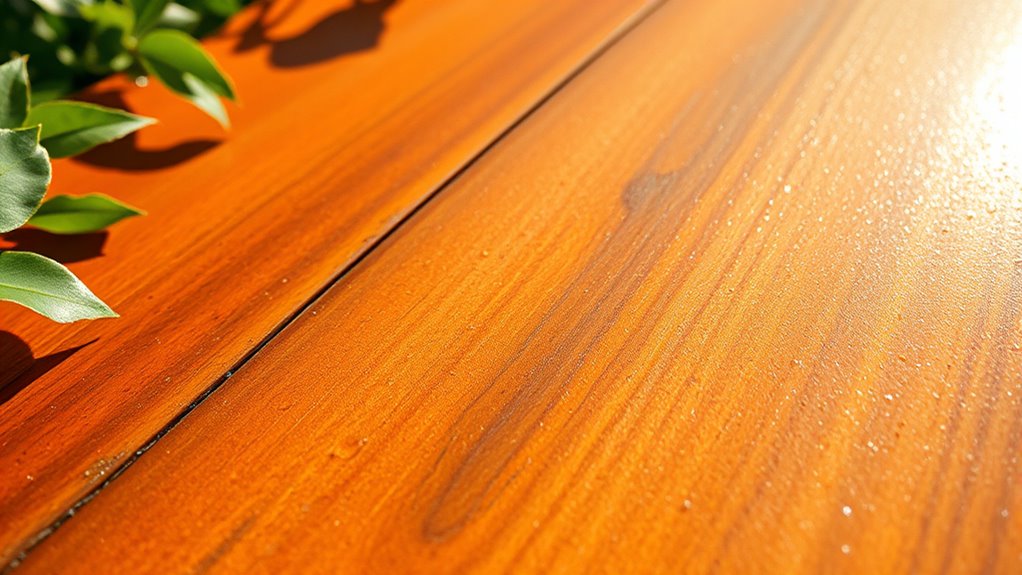
Natural oils are popular choices for protecting wood against moisture because they penetrate deeply into the material, creating a durable, waterproof barrier. You can choose from options like linseed oil, tung oil, Danish oil, and teak oil.
Natural oils like linseed, tung, Danish, and teak penetrate deeply, creating durable, waterproof protection for wood.
Linseed oil, derived from flaxseed, blocks moisture and UV rays while restoring the wood’s natural look.
Tung oil provides an especially tough, non-yellowing finish that resists abrasions and acids.
These oils work by filling microscopic pores in the wood, keeping it flexible and preventing cracks caused by moisture fluctuations.
When exposed to oxygen, they oxidize and harden, forming a dry, protective layer.
Unlike surface coatings, natural oils penetrate from inside out, offering long-lasting moisture resistance while enhancing the wood’s natural beauty.
This process also helps improve adhesion for subsequent coatings and treatments.
Regular reapplication maintains their protective qualities.
Synthetic Sealants and Their Application Techniques
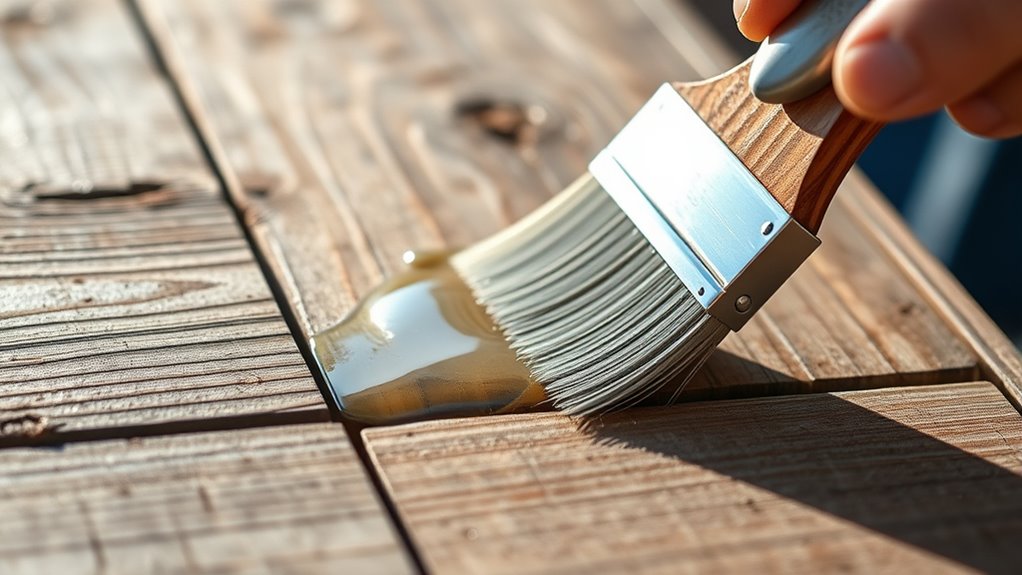
Applying synthetic sealants effectively depends on proper surface preparation and technique. Begin by sanding your wood to 120-150 grit and removing all dust and contaminants. Proper surface preparation is crucial for optimal adhesion and performance. Choose the right tool: natural bristle brushes for oil-based sealants like varnish, or synthetic brushes for water-based options such as acrylic hybrids. Apply thin coats—two to three layers—allowing 4-6 hours to dry between coats. Always work in a controlled environment with temperatures between 50-90°F and humidity below 85%. Use multiple coats to prevent cracking and ensure even coverage. For outdoor surfaces, select UV-stabilized formulations like spar varnish. Proper application maximizes durability, water resistance, and UV protection, helping your wood stay protected and looking its best over time. Additionally, understanding AI-driven discoveries in materials science can lead to the development of more advanced sealants in the future. Staying informed about innovative materials can help you choose the most effective products for long-lasting protection.
Strategies for UV Protection and Damage Prevention

To effectively protect wood from UV damage, you should employ a combination of physical barriers, protective finishes, and regular maintenance. Position your wood furniture or structures in shaded areas or use architectural elements like pergolas, overhangs, or UV-blocking screens to physically shield surfaces. Cover wood with breathable, UV-resistant fabrics when not in use and rotate portable items to prevent uneven exposure. Apply UV-blocking varnishes, lacquers, or polyurethane finishes regularly, and consider tinted coatings with color pigments to enhance UV absorption. Keep surfaces clean to remove dirt that accelerates deterioration and inspect coatings annually for touch-ups. Maintaining consistent moisture levels and avoiding harsh cleaners helps preserve protective layers. Incorporating advanced materials that are designed to resist UV and moisture damage can further extend your wood’s lifespan. Additionally, selecting UV-resistant coatings formulated for outdoor use provides an extra layer of protection against harmful rays. Regular maintenance practices are essential for identifying early signs of damage and ensuring longevity. These strategies work together to minimize UV penetration and extend your wood’s lifespan.
Choosing the Right Wood Oils and Coatings
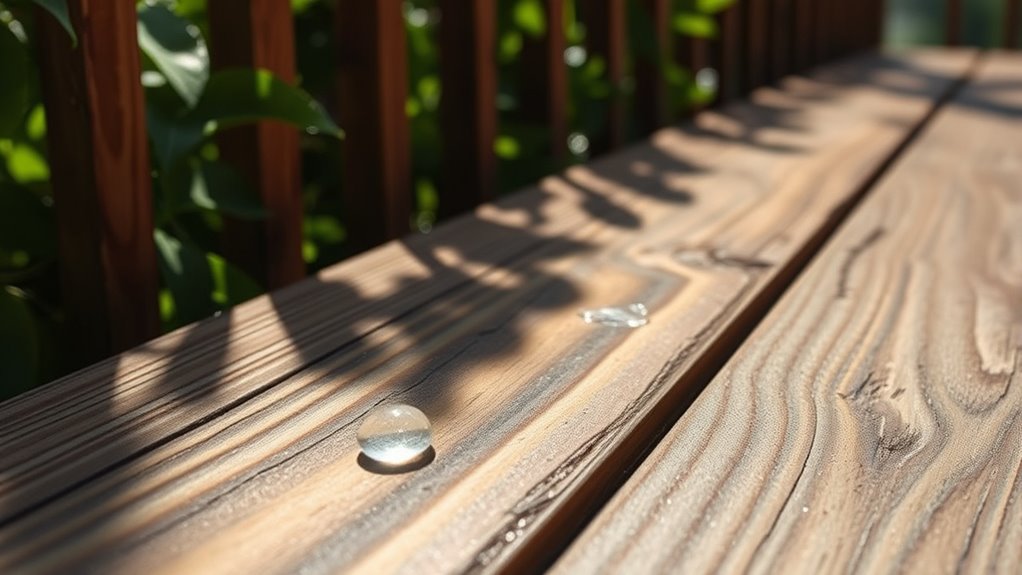
Choosing the right wood oils and coatings is essential for maximizing protection and maintaining the natural beauty of your wood surfaces. UV-protection oils, which are natural oil-based microporous finishes, resist cracking, flaking, and peeling while being water and dirt resistant. UV protection plays a crucial role in preserving wood against sun damage, especially in outdoor settings. Penetrating oils like Textrol saturate wood deeply, providing long-lasting defense against weathering, UV rays, and moisture. Incorporating engine tuning techniques can also optimize the performance and longevity of your protective finishes by ensuring the wood’s environment remains stable. Teak oil works well on dense hardwoods, enhancing grain and offering UV protection. Oil and wax-based coatings resist moisture and are often food safe, making them ideal for interior projects. For best results, apply multiple coats, use quick, easy techniques, and select finishes with UV blockers to preserve your wood’s look and durability. Incorporating affiliate links to trusted brands can help ensure you choose high-quality products that provide optimal protection. To further enhance the durability of your wood, consider selecting finishes that contain UV blockers, which effectively shield against sun damage and prolong the lifespan of your surfaces.
Long-Term Moisture and UV Damage Management
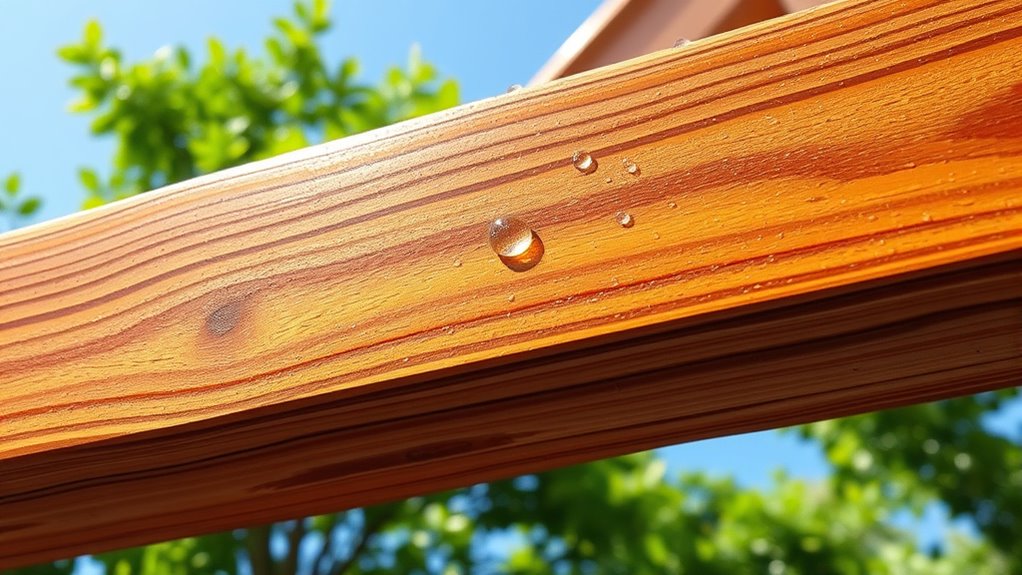
Long-term protection of wood from moisture and UV damage relies on understanding how these factors affect its structural integrity and appearance over time. Moisture penetration weakens fibers and can trap water inside, speeding up rot and causing cracking as the wood expands and contracts. Excess moisture also promotes mold, mildew, and fungi growth.
UV rays break down surface fibers, leading to discoloration, erosion, and reduced natural oils, which lowers moisture resistance. To manage these risks, store wood in dry, covered areas and use vapor barriers during installation.
Regularly reapply protective coatings like varnish or sealants, but avoid over-application that traps moisture. Combining water-based preservatives with pigmented oils offers long-term defense by enhancing water repellency and UV protection simultaneously.
Frequently Asked Questions
How Often Should Wood Be Re-Treated for Optimal Moisture Protection?
You should re-treat your wood at least once a year to keep it moisture-resistant. Outdoor wood typically needs reapplication every 12 to 18 months, but factors like climate, wood type, and exposure can shorten this interval.
Keep an eye on signs like color fading, water absorption, or surface cracks, and reapply as needed. Regular inspections help guarantee your wood stays protected and looks great longer.
Can Natural Oils Be Used on Outdoor Furniture Without Additional Sealants?
You can use natural oils on outdoor furniture without extra sealants, but keep in mind they don’t form a tough surface layer. Natural oils like tung or teak oil penetrate deeply and offer UV and mold protection, yet they need regular reapplication to maintain effectiveness.
For heavy wear or extreme weather, adding a sealant can provide extra durability.
Are There Eco-Friendly Options for Uv-Resistant Wood Coatings?
You’re asking if eco-friendly options exist for UV-resistant wood coatings. The good news is, yes, there are environmentally safe choices. Water-based urethane, bio-polyurethane finishes, and low-VOC stains offer effective UV resistance while minimizing harmful emissions.
These coatings protect your wood from UV damage, extend its lifespan, and support sustainability. They’re ideal if you want performance without compromising your eco-conscious values.
What Are Signs That a Wood Treatment Is No Longer Effective?
Imagine you’re a detective uncovering signs of a failing wood treatment. You notice discoloration, fading, or chalking on the surface—like a vintage photograph losing its color.
Soft spots, cracks, or splinters indicate internal decay. A musty smell or mold suggests moisture breach.
Warping or structural weakness confirms the treatment’s lost efficacy. These clues tell you it’s time for a reapplication to keep your wood protected and looking good.
How Does Climate Influence the Choice of Moisture and UV Protection Methods?
Climate plays a big role in your choice of protection methods. If you’re in a humid or rainy area, you’ll want water-repellent treatments and moisture barriers to prevent decay.
In sunny, tropical zones, dual-action preservatives with UV blockers are essential.
Cooler or arid regions might focus on UV stabilization and less intensive moisture protection.
Adjust your approach based on your climate to keep your wood durable and looking good longer.
Conclusion
You might worry that oils and sealants won’t last forever, but with proper application and regular maintenance, they can remarkably extend your wood’s lifespan. Don’t assume that natural options are less effective—they often provide excellent moisture and UV protection when used correctly. By choosing the right products and applying them properly, you’ll keep your wood looking great and standing strong for years to come. Protecting your wood isn’t complicated, just consistent.
